Storytelling in the Classroom
advertisement
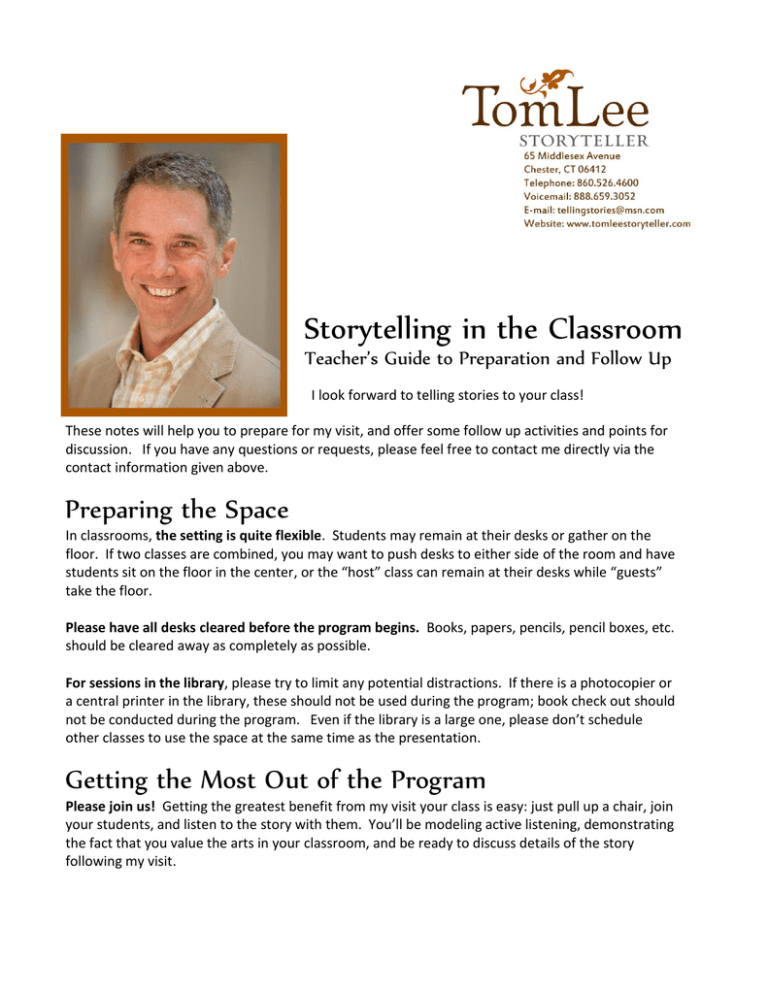
Storytelling in the Classroom Teacher’s Guide to Preparation and Follow Up I look forward to telling stories to your class! These notes will help you to prepare for my visit, and offer some follow up activities and points for discussion. If you have any questions or requests, please feel free to contact me directly via the contact information given above. Preparing the Space In classrooms, the setting is quite flexible. Students may remain at their desks or gather on the floor. If two classes are combined, you may want to push desks to either side of the room and have students sit on the floor in the center, or the “host” class can remain at their desks while “guests” take the floor. Please have all desks cleared before the program begins. Books, papers, pencils, pencil boxes, etc. should be cleared away as completely as possible. For sessions in the library, please try to limit any potential distractions. If there is a photocopier or a central printer in the library, these should not be used during the program; book check out should not be conducted during the program. Even if the library is a large one, please don’t schedule other classes to use the space at the same time as the presentation. Getting the Most Out of the Program Please join us! Getting the greatest benefit from my visit your class is easy: just pull up a chair, join your students, and listen to the story with them. You’ll be modeling active listening, demonstrating the fact that you value the arts in your classroom, and be ready to discuss details of the story following my visit. Assessment Observing your students listening to a story is a great way to assess their learning. It’s a chance to see how your class responds to a different teaching style. For most students, listening to a story being told, is an unusual experience. The way they respond to it can tell you a lot. Engagement Many students listen with absolute attention as they visualize the story and construct its meaning in their own minds. It’s interesting to see which students listen to the entire story in this way, and which might drift in and out of attention. What brings them back to full engagement? Differentiated Instruction Storytelling is the original differentiated instruction strategy! Students of all abilities and backgrounds can fully engage in the same story. Each child’s personal responses and interpretations are equally valid and meaningful. Activation of Prior Knowledge Listening to a folktale or a myth, students constantly need to access their prior knowledge to make sense of the story. It’s often surprising to discover the levels of prior knowledge student have on different subjects, and impossible to predict which parts of a story will evoke these responses. Visualization During one performance I gave, a young student blurted out “Hey, I can see it!” in the middle of the story. Listening to stories evokes a strong visual response in the mind. I often ask them to describe what they see, either in discussion or in writing following the story Making and Supporting Inferences Folktales often rely on different levels of implied or inferred meaning. Do characters always mean what they say? How does a character feel at a given point in the story? What might happen next? I will punctuate a story with questions like this to be sure my listeners fully grasp the story. Connections with Self, Text, and World I never know when a story I tell will spark a connection. A theme, a setting, a particular word – anything can link a story I’m telling to a child’s world. When such connections emerge, I may pause the story to discuss them. If you see an opportunity to make a connection between my story and your current instruction, please feel free to introduce this idea. What makes a story a folktale? Folktales are, simply, stories created by “the folk.” “The folk” the common members of a society, not the rulers, judges, teachers, or religious leaders. As most students can tell you, folktales were “passed down from generation to generation by word of mouth.” I think it’s important to think about what this really means. I will often ask students why these stories were passed on by word of mouth rather than in written form. In many traditional cultures, stories were created by people who could not read or write. Stories could only survive if they were remembered and retold. Once a story was forgotten, it was gone forever. Early in the 1800s, scholars began collecting these “tales of the folk” by writing down stories they heard. Two such scholars were the brothers Ludwig and Jacob Grimm who collected the stories we now know as “Grimm’s Fairy Tales.” In fact, not every story in this wonderful collection was told to the Grimm’s by a member of the folk; some came from other scholars or books of ancient ballads, but the Grimm brothers started a world-wide movement to collect traditional stories. Many of the stories in the folktale collections we read today were first collected in the 1800s. Common elements of folktales The more folktales we encounter, the more likely we are to notice common elements among the stories. Why is this so? There are dozens of theories. Perhaps it was because of the way stories travelled around the world, being adapted and altered by each new teller to fit in with new cultures and languages. Perhaps very similar stories sprang up independent of one another in different parts of the world as part of a great “collective unconscious. Whatever the reason, here are some of the elements we often find in folktales: The setting is vague: an unspecified timer or place Events occur in multiples of 3, 7, or 12 The story often beings with a departure from home Three siblings, with the youngest considered a fool The hero or heroine is in quest of a magical object Transformation from human to animal A magical helper, human or animal, gives advice The hero or heroine is faces an impossible task That’s “folk,” not “fake” Students will sometimes describe folktales as “fake.” I encourage them instead to use the terms “fantasy” or “unrealistic fiction.” I will sometimes present older students with the puzzling fact that folktales and fairy tales are all classified as “non-fiction” in the library. Really! This reminds us that, even though most of the stories describe impossible events, the tales themselves are genuine, vital elements of the cultures that created them. Folktales versus fairytales Perhaps the question teachers ask more than any other is about the differences between “folktales” and “fairytales.” The fact is, from a historical point of view, there’s really no difference at all. When the first serious researchers began collecting stories from tellers who were themselves unable to write, they weren’t sure what to call them. One researcher, W. J. Thoms, suggested the word “folklore” in 1846. The word “fairy tales” comes from the French term “Contes de Fées,” first used by Charles Perrault who published elaborately written versions of traditional tales like Cinderella and Puss in Boots more than a hundred years before the Brothers Grimm published their stories Really, the word “fairytale” is a misnomer. There are very few fairies in fairytales. To quote J. R. R. Tolkien, the author of The Hobbit: Stories that are actually concerned primarily with “fairies,” that is with creatures that might also in modern English be called “elves,” are relatively rare, and as a rule not very interesting. But the question still persists. If teachers really feel they need to make a distinction between folktales and fairytales, I suggest this distinction. While both types of story come from the oral tradition, some rely on magical events to move the story forward, while others have no magic at all and thus are actually possible, if completely unlikely. Folktales versus fables The difference between folktales and fables is much easier to define. Not all fables were created by “the folk.” Many were created in writing by scholars, philosophers and religious teachers, although these quickly passed into oral tradition. Fables are very short stories created specifically to teach a lesson about some aspect of human behavior. Fables show us how wise or how silly we can be. Characters in fables are usually animals that speak and behave just like humans. Fables are tricky. Just because they’re short doesn’t mean they are simple, or easily understood. Grasping the moral or lesson of a fable usually requires listeners to understand things that are implied, rather than directly stated. Many fables require highly abstract thinking. Contact me: If have a question, a comment, a request, or a suggestion, I would be delighted to hear from you! E-mail: tellingstories@msn.com Web: www.tomleestoryteller.com Facebook: Tom Lee Storyteller
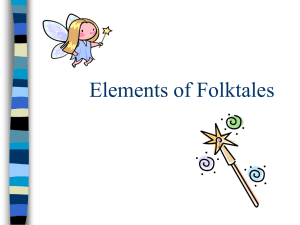
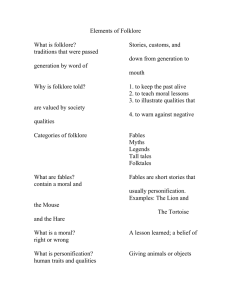
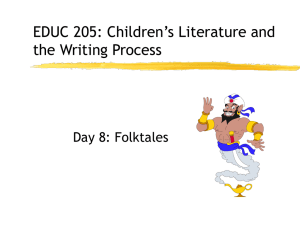
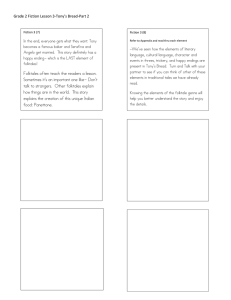
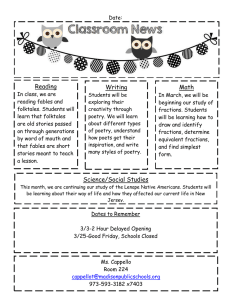
![Essay #4: [4 Short essays will substitute Essay 4]](http://s3.studylib.net/store/data/007737676_2-779981057889e025637152af438b827f-300x300.png)